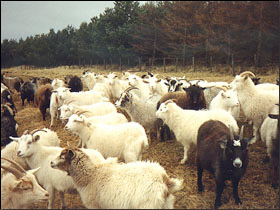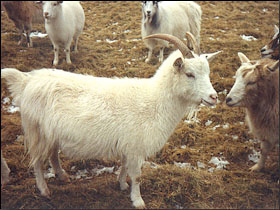 Cashmere is the down produced by the skin’s secondary hair follicles, which grows in response to decreasing day-length, thus protecting the goat from the winter cold much more efficiently than do the guard-hairs produced by the primary hair follicles (these coarser hairs make up the visible coat of the animal). Thus the word “cashmere” describes the down, not the goat, and many goats have the genetic makeup that enables them to produce down.
Cashmere is the down produced by the skin’s secondary hair follicles, which grows in response to decreasing day-length, thus protecting the goat from the winter cold much more efficiently than do the guard-hairs produced by the primary hair follicles (these coarser hairs make up the visible coat of the animal). Thus the word “cashmere” describes the down, not the goat, and many goats have the genetic makeup that enables them to produce down.
 To be acceptable for processing, however, cashmere fibres must be as fine as possible, and by definition the diameter must not exceed 18.5 microns. Other properties are also required – a suitable length (about 4.5 cm.), construction, crimp and colour (white ismore valuable than brown or grey). Before spinning, the inevitable guard hairs shed when the cashmere moults out in the spring must be removed. For this reason cashmere processing is currently an industrial, rather than a domestic procedure.
To be acceptable for processing, however, cashmere fibres must be as fine as possible, and by definition the diameter must not exceed 18.5 microns. Other properties are also required – a suitable length (about 4.5 cm.), construction, crimp and colour (white ismore valuable than brown or grey). Before spinning, the inevitable guard hairs shed when the cashmere moults out in the spring must be removed. For this reason cashmere processing is currently an industrial, rather than a domestic procedure.
